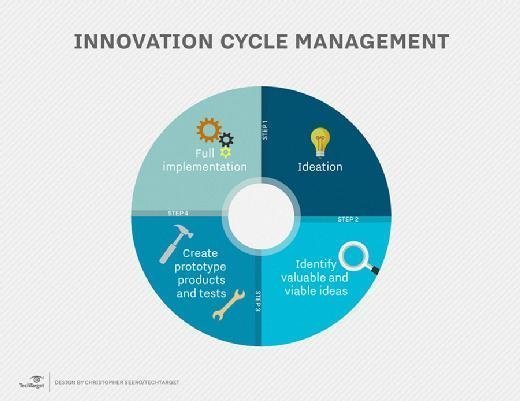business innovation
What is business innovation?
Business innovation is an organization's process for introducing new ideas, workflows, methodologies, services or products.
Like IT innovation, which calls for using technology in new ways to create a more efficient and agile organization, business innovation should enable the achievement of goals across the entire organization, with sights set on accomplishing core business aims and initiatives.
Innovation often begins with idea generation, wherein ideas are narrowed down during brainstorming sessions, after which leaders consider the business viability, feasibility and desirability of each idea.
Business innovation should improve on existing products, services or processes, solve a problem or reach new customers.
Recent examples of business innovation include the Dyson vacuum cleaner, whose creator and namesake James Dyson declared in advertisements that he set out to build a better product by applying industrial cyclone technologies to the household appliance. Ride-sharing companies, such as Zipcar, Uber and Lyft, represent an example of a service innovation. Gillette has billed its Mach3 razors as containing innovative technology.
Why business innovation is important
The purpose of the business innovation process is to create value for the organization. That value can come from the following areas:
- Creating new revenue opportunities or driving more revenue through existing channels.
- Creating efficiencies that save time, money or both.
- Creating improvements to productivity or performance.
In short, innovation should lead to higher profits.
Additionally, the results of an organization's innovation process should yield a competitive advantage; it should help the organization to grow and reach -- or, better still, exceed -- strategic objectives.
Innovation vs. invention
Innovation and invention are closely linked, but the two terms are not interchangeable.
An invention is an entirely new creation. The process of business innovation can produce an invention. However, the term is broader in scope and includes the application of an existing concept or practice in a new way or applying new technology to an existing product or process to improve upon it.
To better understand the difference, consider this: The telephone is an invention, but the smartphone is an innovation.
The business innovation cycle
Although there's no one-size-fits-all formula for business innovation, organizations that are continually successful at business innovation have a repeatable process to generate, test and develop ideas that can lead to innovations.
The cycle is often broken down into four parts. It starts with articulating ideas around key areas, such as business models, marketing, processes, products and services. The cycle moves through discovery then onto development and delivery.
The first phase focuses on the creation and recording of ideas as well as the preliminary evaluation of whether those ideas could produce value.
The next phase centers on testing the ideas through pilot programs or proof of concept, during which ideas and their value are further evaluated.
The last two phases center on scaling ideas, moving them into production and integrating them into normal business operations.
Business leaders often use different names for each of these phases. For example, some label the first phase ideation and the last phase implementation, but the steps for each phase are basically the same.

Some executives and managers further break down the cycle into even more phases, separating items such as analysis, testing and review as separate steps.
Models of innovation
Business innovation can be grouped into various categories, or models. Some are self-explanatory, such as product or process innovations. Other types, and what they mean, include the following:
- Business model innovation: the development and implementation of new, unique concepts supporting an organization's financial viability, including its mission.
- Industry model innovation: the creation of a new industry or an organization's move into a new industry.
- Revenue model innovation: improvements and/or changes to an organization's framework for generating revenue, a goal also encompassed by the term, business model innovation.
Revolutionary vs. evolutionary
Business innovation can also be classified as either revolutionary or evolutionary.
Revolutionary business innovation yields a drastic change in a product, service, process, etc., which often destroys or supplants an existing business model. This is also known as radical innovation.
Evolutionary or incremental innovation involves smaller, more continuous improvements that, while important, are not drastic enough to shift a company or market into a new paradigm.
Disruptive innovation is a category that emphasizes the destructive aspect of revolutionary innovation; this term applies to business innovation that leads to the creation of a new market that displaces an existing one or, similarly, a significant upheaval in a category of products or services.
The pros and cons of business innovation
Business innovation, like most business initiatives, has both benefits and risks.
Organizations should recognize on the negative side that the business innovation process can be a costly undertaking that does not always produce a return on investment; that ideas deemed likely to succeed could still fail; and that stakeholders -- whether they're employees, customers, partners or others -- could fight the changes required to be successful.
On the other hand, organizations need to weigh those risks against the benefits of business innovation. Those benefits include the development of improved products and services, increased revenue and market share, organizational growth and new opportunities, and recognition as a leader.







